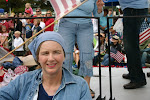Emus Loose in Egnar: Big Stories from Small Towns by Judy Muller (University of Nebraska Press 2011)
By Lyn Jensen
“With all the hand-wringing about the “death of journalism,” it is more than a little ironic that small-town newspapers have been thriving by practicing what the mainstream media are now preaching: Hyper-localism, Citizen Journalism, Advocacy Journalism—these are some of the latest buzzwords of the profession,” so begins Emus Loose in Egnar. “But the concepts have been around for ages at small-town newspapers.”
Award-winning journalist Judy Muller argues in her latest book that the press—in the form of print media industry--still thrives in small-town communities for “the corniest of reasons: our freedoms depend on it.” It’s a job small towns will probably always need done.
Some may take exception to Muller’s use of “corniest” to describe freedoms guaranteed under the First Amendment, but in Emus she guides readers through dozens of small-market communities and their newspapers. She finds towns where generations of journalists have, often at considerable risk, spent their lives reporting on racial strife and other extremely controversial topics. She finds even in relatively quiet communities, police blotter stories (such as loose emus in Egnar, Colorado), school sports, and local obituaries provide towns with a method of communication that new media simply can’t match.
Muller lives in the small town of Norwood, Colorado, when she’s not teaching journalism at USC, so she’s able to provide first-hand observations of that town’s rivalry with nearby Tellerude as reported through the local papers. Although she makes a convincing argument that community journalism in its print form isn’t dead (my primary employer Random Lengths is one of many outlets that prove that), she’s less successful at demonstrating a workable business model for professional journalists to follow.
Many of the businesses she spends time with have slim budgets and overhead, and don’t appear to boast full-time professional experienced or trained staff. Many are portrayed as somehow getting by with part-timers, volunteers, and a few people who admit they can’t write but object to being edited.
Muller’s book makes a persuasive case for the need for small-town newspapers but just how those papers are expected to provide a source of income for their publishers and employees—who sometimes risk firebombing and just plain dislike—is a more difficult question and a subject for another book.



0 Comments:
Post a Comment
Subscribe to Post Comments [Atom]
<< Home